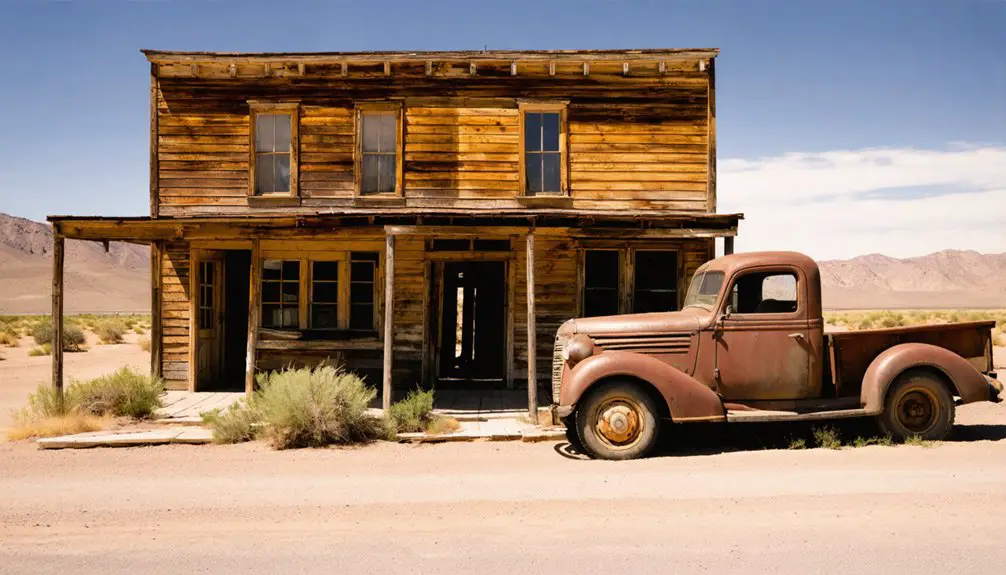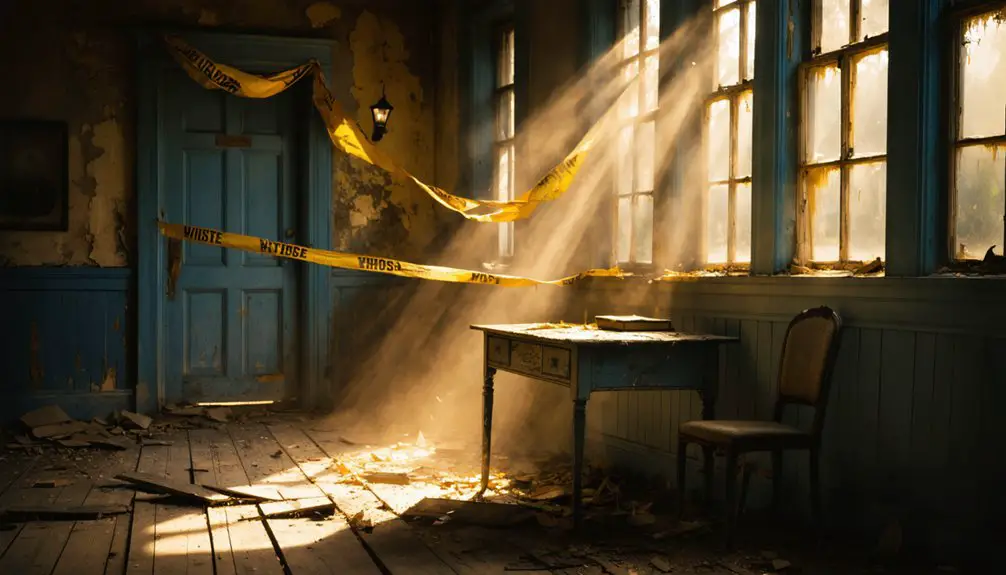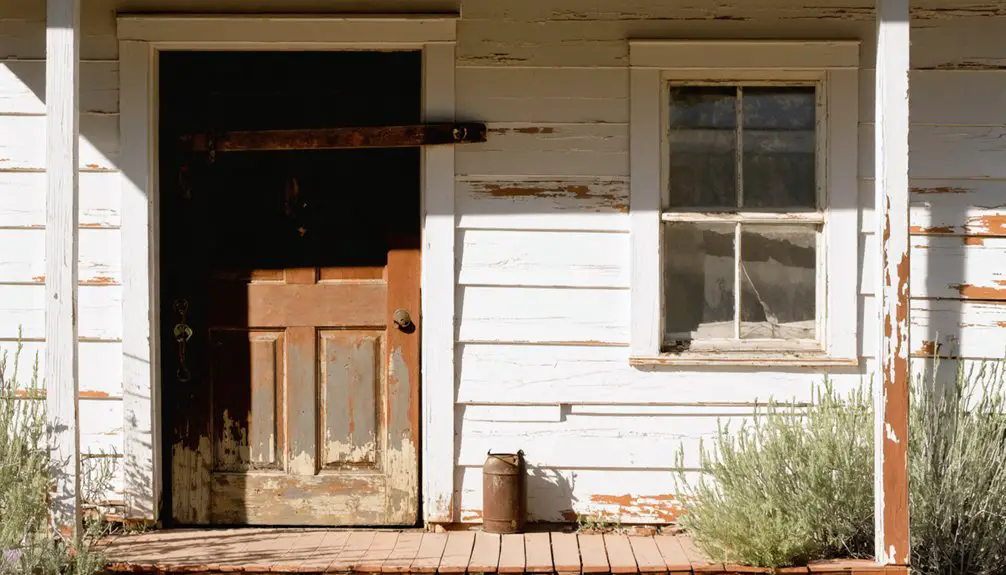You’ll find several fascinating ghost towns scattered across Garfield County, Utah, including the well-preserved Grafton from the 1859 Cotton Mission and Widtsoe near Bryce Canyon. These abandoned settlements tell stories of mining booms, agricultural ventures, and pioneer determination in the face of harsh frontier conditions. From Garfield’s copper mining legacy to Osiris’s stone creamery ruins, each site offers unique glimpses of Utah’s past. The deeper you explore these historic places, the more secrets they reveal.
Key Takeaways
- Garfield County contains five significant ghost towns, including Widtsoe, Eagle City, Clifton, Georgetown, and Osiris, each telling unique pioneer stories.
- Widtsoe, located near Bryce Canyon, was abandoned in 1936 due to drought and Great Depression hardships.
- Grafton, established in 1859 for cotton cultivation, features five preserved structures including a schoolhouse and Russell home.
- The town of Garfield, founded by Utah Copper Co. in 1905, was abandoned by 1957 after Kennecott ceased operations.
- Ghost towns in Garfield County offer historical exploration opportunities but require 4WD vehicles and proper safety preparations.
The Rise and Fall of Garfield County’s Forgotten Settlements
While indigenous peoples had inhabited Garfield County for millennia, the late 19th and early 20th centuries marked a dramatic transformation of the region’s settlement patterns.
You’ll find evidence of this rich cultural legacy at sites like Dead Man’s Cave, where artifacts date back to 7,000 B.C., and the once-thriving Coombs Village, a major Native American trade center.
The mining impact reshaped the landscape dramatically when Utah Copper Co. established Garfield in 1905. At its peak in the 1940s, the town reached a population of about 2,000 residents.
The arrival of Utah Copper Co. in 1905 forever altered Garfield’s terrain, turning pristine wilderness into an industrial mining landscape.
Like many mining towns of its era, Garfield flourished briefly before facing decline. By 1955, Kennecott Copper’s decision to stop managing residential properties led to the town’s abandonment. The town’s strategic location along Interstate 80 and 201 made it an important transportation hub during its active years.
You can trace similar patterns in settlements like Widtsoe, which existed from 1908 to 1936, succumbing to the harsh realities of frontier life.
Grafton: a Well-Preserved Window Into Pioneer Life
You’ll find Grafton’s surviving buildings offer remarkable insights into Utah’s Virgin River Cotton Mission of 1859, when Brigham Young directed Mormon pioneers to establish cotton-growing settlements in the region.
Today, five original structures still stand, proof of the determination of those first 28 families who relocated here after floods destroyed their initial settlement at Wheeler.
These historic buildings, including the schoolhouse and Russell home, showcase the distinctive architectural style of Mormon pioneer settlements while telling the story of early agricultural efforts along the Virgin River. The site offers stunning views of Grafton Mesa and surrounding landscapes. Visitors can explore these preserved structures without paying admission, making it an accessible destination for those interested in pioneer history.
Historical Buildings Stand Today
Standing as proof of Utah’s pioneer heritage, Grafton’s remarkably preserved buildings offer visitors an authentic window into 19th-century Mormon settlement life.
You’ll find historical architecture that’s withstood decades of preservation challenges, including the iconic 1886 schoolhouse with its handmade adobe bricks and lava rock foundation. The Russell and Wood homes, built in the 1870s and 1880s, showcase the ingenuity of pioneer construction methods. Located near the Virgin River banks, the town’s buildings demonstrate the determination of settlers who rebuilt multiple times despite flooding challenges. The site’s ongoing maintenance is overseen by the Grafton Heritage Partnership, ensuring these structures remain accessible to the public.
- The two-story schoolhouse served triple duty as church, classroom, and community gathering space
- Original outbuildings, including a weaving house, reveal daily pioneer life activities
- Unmodernized structures maintain their authentic 19th-century character
- Local heritage organizations partner with the National Park Service to preserve these irreplaceable landmarks
Virgin River Cotton Mission
These preserved buildings stand as remnants of an ambitious agricultural endeavor known as the Virgin River Cotton Mission. In the late 1850s, you’d have found Mormon pioneers establishing farms along Utah’s “Dixie” region, with Grafton founded in 1859 as one of eight initial settlements.
Under Brigham Young’s direction, the pioneer community focused on cotton cultivation alongside figs, grapes, and subsistence crops. The settlement quickly grew to include 168 peak residents by 1861. The settlers faced severe hardship when overplanting cotton led to widespread food shortages.
You’ll discover that life wasn’t easy for these settlers. The Virgin River’s unpredictable floods destroyed the original Grafton settlement in 1862, forcing relocation upstream.
Conflicts with Southern Paiute and Navajo tribes in 1866 led to temporary abandonment. By 1906, recurring floods and Hurricane’s superior irrigation system drew settlers away, leaving Grafton to become the ghost town you can explore today.
Notable Ghost Towns Across the County
You’ll find Widtsoe’s abandoned storefronts and weathered structures about 15 miles northeast of Bryce Canyon, where over 1,100 residents once lived during the town’s early 1910s peak.
The remnants of Eagle City and Asay stand as evidence to the region’s boom-and-bust cycles, though little remains of their original buildings and communities.
Throughout Garfield County, ghost towns like Clifton, Georgetown, and Osiris reveal glimpses of pioneer life through their scattered foundations, old mining equipment, and architectural fragments. These sites are thoughtfully organized by county to help visitors efficiently plan their exploration routes.
Hidden Ruins Worth Exploring
Deep within Garfield County’s rugged terrain lie five fascinating ghost towns, each telling a unique story of Utah’s pioneer spirit.
These hidden treasures await urban exploration, from Osiris’s stone creamery ruins to Widtsoe’s weathered hotels near Bryce Canyon. You’ll discover remnants of pioneer life scattered across the landscape, from Eagle City’s mining ruins in Bromide Basin to Stateline’s historic mill sites. Founded by W.F. Holt in 1920, Osiris emerged from the purchase of Henderson Ranch to revitalize drought-stricken interests in the region.
- Osiris offers impressive stone structures along John’s Valley Road, including a granary that’s stood against time.
- Widtsoe’s pioneer cemetery provides a poignant glimpse into early settler life.
- Eagle City’s cabin ruins in the Henry Mountains reveal the region’s mining heritage.
- Grafton’s one-room schoolhouse stands as a monument to Mormon pioneers who battled relentless floods.
Last Traces Of Settlement
Among Garfield County’s most historically significant ghost towns, Widtsoe stands as a memorial to early 20th-century agricultural ambition.
Once home to over 1,100 residents, today you’ll find only faint settlement remnants where stores, hotels, and sawmills once thrived.
Nearby Grafton offers more tangible connections to the past, with its preserved cemetery and structural remains marking its brief tenure as county seat.
Archaeological findings at smaller settlements like Asay and Eagle City reveal the county’s diverse history of farming and mining ventures.
You can still trace the foundations of these communities, though time has largely reclaimed them.
In remote corners of the county, ghost towns like Lossee, Georgetown, and Osiris have left minimal physical evidence, their stories now preserved mainly in historical records.
Historical Events That Shaped Town Abandonments
Throughout Garfield County’s history, several distinct forces converged to transform thriving communities into ghost towns. You’ll find the region’s story marked by environmental challenges like the devastating 1930s drought that struck Widtsoe, alongside economic changes that reshaped mining towns like Garfield.
The Great Depression dealt crushing blows to these vulnerable communities, while shifting transportation routes bypassed once-vital settlements.
- The closure of Kennecott Copper’s operations in 1955 led to Garfield’s complete abandonment by 1957.
- Ancient Coombs Village faced mysterious abandonment centuries before modern ghost towns emerged.
- Drought combined with the Depression forced Widtsoe’s residents to seek opportunities elsewhere.
- New interstate highways redirected traffic and commerce away from established communities.
Planning Your Ghost Town Adventure

Before starting your Garfield County ghost town expedition, you’ll need to carefully plan your adventure to safely explore these fascinating historical sites.
Equip yourself with a 4WD vehicle, as many locations like Eagle City in the Henry Mountains require off-road capabilities. Pack essential survival gear including water, food, first aid supplies, and reliable navigation tools, since you won’t find services at these remote locations.
A high-clearance 4WD vehicle and proper survival gear are essential for safely reaching these remote ghost towns in Garfield County.
For ideal ghost town exploration, time your visits during early morning or late afternoon for the best photography conditions. Research each site’s access rights, particularly for places like Widtsoe and Asay Town, and inform someone of your travel plans.
Don’t forget sturdy hiking boots, weather-appropriate clothing, and backup power for your devices – cell service is virtually non-existent in these isolated areas.
Preservation Efforts and Historical Significance
While exploring these remote sites offers a fascinating glimpse into the past, preserving Garfield County’s ghost towns has become a major focus of historical organizations across Utah.
The Utah Ghost Town Project leads preservation challenges through detailed documentation, photography, and research of sites like Widtsoe, which once housed 1,100 residents. You’ll find these efforts critical in maintaining the historical context of early 20th-century frontier life.
- The Utah Ghost Town Association provides public access to location data and historical information through platforms like Google Maps
- Restoration work emphasizes period-appropriate materials to maintain authenticity
- Partnerships between private owners and agencies secure funding for site protection
- Historical markers and guided tours help preserve public memory while supporting conservation
Safety Tips for Exploring These Historic Sites

When venturing into Garfield County’s ghost towns, you’ll need to prioritize safety given the remote desert terrain and unique hazards of these historic sites.
Pack essential safety gear including first aid supplies, navigation tools, and emergency communication devices, as cell service is unreliable in the Grand Staircase-Escalante region.
Stay alert for wildlife and maintain a safe distance while exploring. You’ll need to verify legal access routes beforehand and obtain necessary permissions for private lands.
Watch for unstable structures and follow established trails to prevent erosion. Don’t forget to bring plenty of water and inform others of your plans.
During your visit, respect local ordinances by avoiding damage to signs or fences, and be prepared for sudden weather changes, particularly flash floods in canyon areas.
Frequently Asked Questions
Are There Any Reported Paranormal Activities in Garfield County’s Ghost Towns?
You’ll find zero officially documented paranormal investigations in Garfield County’s haunted locations, though local folklore occasionally mentions unexplained phenomena. The region’s ghost towns attract more history buffs than ghost hunters.
Can Metal Detectors Be Used to Explore These Ghost Town Sites?
You can’t freely metal detect in these sites due to strict regulations protecting historical artifact preservation. You’ll need proper permits and must follow local laws to avoid legal consequences.
Which Ghost Towns Have the Most Artifacts Still Visible on Site?
Scattered metal and wood fragments catch your eye at Widtsoe, where you’ll find the most visible artifacts. Its preserved foundations, cemetery items, and daily life remnants showcase superior historical significance compared to Mercur’s limited remains.
Are Overnight Camping Stays Allowed Near Any Ghost Town Locations?
You’ll need to follow camping regulations and stay in designated areas only. Due to historical significance, you can’t camp directly in ghost towns but may find permitted sites nearby on public lands.
Do Any Descendants of Original Settlers Still Maintain Properties There?
Like scattered seeds taking root, you’ll find some descendants maintain family properties, particularly near Grafton. Descendant interviews reveal occasional property restoration efforts, though most ghost town lands remain largely untended.
References
- https://www.utahsadventurefamily.com/grafton-ghost-town/
- https://en.wikipedia.org/wiki/Category:Ghost_towns_in_Garfield_County
- https://jacobbarlow.com/2020/03/03/ghost-towns-in-utah/
- https://wikipedia.nucleos.com/viewer/wikipedia_en_all/A/List_of_ghost_towns_in_Utah
- http://www.expeditionutah.com/forum/index.php?threads/utah-ghost-town-project-site-location-list.4210/
- https://onlineutah.us/garfieldhistory.shtml
- https://www.deseret.com/2005/8/12/19906627/memories-of-a-company-town/
- https://nhmu.utah.edu/explorer-corps/marker/garfield
- https://www.familysearch.org/en/wiki/Utah_Ghost_Towns
- https://en.wikipedia.org/wiki/Widtsoe



